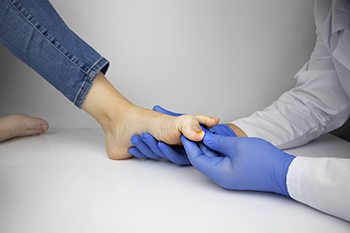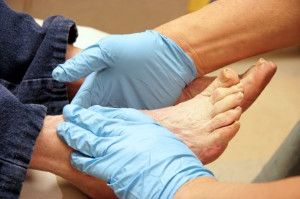Connect With Us
Blog
Items filtered by date: March 2024
Excess Weight and Circulatory Issues of the Feet

Poor circulation in the feet refers to reduced blood flow to the lower extremities, leading to symptoms like cold feet, numbness, tingling, and slow wound healing. It occurs when blood vessels become narrowed or blocked, restricting the flow of oxygen-rich blood to the feet. Typical causes of poor circulation include peripheral artery disease, atherosclerosis, diabetes, smoking, high blood pressure, and high cholesterol levels. Obesity can exacerbate poor circulation in the feet due to several factors. Excess body weight increases the workload on the heart and blood vessels, leading to conditions like hypertension and atherosclerosis. Fat accumulation around blood vessels can also compress them, further impairing blood flow. Managing poor circulation involves lifestyle changes like regular exercise, maintaining a healthy weight, quitting smoking, and controlling underlying medical conditions. In severe cases, medical interventions like medications or surgical procedures may be necessary to improve blood flow. If you have symptoms of poor circulation in your feet, it is suggested that you schedule an appointment with a podiatrist for a proper diagnosis and treatment.
Obesity has become very problematic at this point in time and can have extremely negative effects on the feet. If you’re an obese individual and are concerned about your feet, contact Eugene Little, DPM from Foot and Ankle Centers of Ohio. Our doctor can provide the care you need to keep you pain-free and on your feet.
Obesity and Your Feet
Since your feet are what support your entire weight when standing, any additional weight can result in pain and swelling. Being overweight is one of the main contributors to foot complications.
Problems & Complications
Extra Weight – Even putting on just a few extra pounds could create serious complications for your feet. As your weight increases, your balance and body will shift, creating new stresses on your feet. This uneven weight distribution can cause pain, even while doing the simplest tasks, such as walking.
Diabetes – People who are overweight are at serious risk of developing type-2 diabetes, which has a drastic impact on the health of your feet. As you get older, your diabetes might worsen, which could lead to loss of feeling in your feet, sores, and bruises. You could also become more prone to various infections.
Plantar fasciitis – Pressure and stress that is placed on muscles, joints, and tendons can trigger plantar fasciitis, which is an inflammation of tissue that forms along the bottom of the foot.
If you have any questions please feel free to contact our office located in Sidney, OH . We offer the newest diagnostic and treatment technologies for all your foot and ankle needs.
Who Is Most Prone to Ingrown Toenails?
 Ingrown toenails, a condition where the nail grows into the skin surrounding it, can affect certain people due to a combination of genetic predispositions, lifestyle choices, and physical activities. People can inherit toenail shapes that are more susceptible to becoming ingrown, such as overly curved or thick nails. These people may also have a familial history of the condition. Additionally, athletes and those engaged in activities that place repeated pressure on the toes, such as soccer, ballet, or running, are at a heightened risk due to the constant stress and trauma to the toenails. Improper footwear that constricts the toes can further exacerbate the likelihood of developing this painful condition. Additionally, improper nail care practices, including cutting toenails too short or with rounded edges, can result in the nail growing into the surrounding skin. Recognizing these risk factors can help you prevent ingrown toenails in the future. If you are suffering from an ingrown toenail, it is suggested you visit a podiatrist. This type of doctor can effectively treat ingrown toenails and offer you suggestions for prevention based on any risk factors you may have.
Ingrown toenails, a condition where the nail grows into the skin surrounding it, can affect certain people due to a combination of genetic predispositions, lifestyle choices, and physical activities. People can inherit toenail shapes that are more susceptible to becoming ingrown, such as overly curved or thick nails. These people may also have a familial history of the condition. Additionally, athletes and those engaged in activities that place repeated pressure on the toes, such as soccer, ballet, or running, are at a heightened risk due to the constant stress and trauma to the toenails. Improper footwear that constricts the toes can further exacerbate the likelihood of developing this painful condition. Additionally, improper nail care practices, including cutting toenails too short or with rounded edges, can result in the nail growing into the surrounding skin. Recognizing these risk factors can help you prevent ingrown toenails in the future. If you are suffering from an ingrown toenail, it is suggested you visit a podiatrist. This type of doctor can effectively treat ingrown toenails and offer you suggestions for prevention based on any risk factors you may have.
Ingrown toenails may initially present themselves as a minor discomfort, but they may progress into an infection in the skin without proper treatment. For more information about ingrown toenails, contact Eugene Little, DPM of Foot and Ankle Centers of Ohio. Our doctor can provide the care you need to keep you pain-free and on your feet.
Ingrown Toenails
Ingrown toenails are caused when the corner or side of a toenail grows into the soft flesh surrounding it. They often result in redness, swelling, pain, and in some cases, infection. This condition typically affects the big toe and may recur if it is not treated properly.
Causes
- Improper toenail trimming
- Genetics
- Improper shoe fitting
- Injury from pedicures or nail picking
- Abnormal gait
- Poor hygiene
You are more likely to develop an ingrown toenail if you are obese, have diabetes, arthritis, or have any fungal infection in your nails. Additionally, people who have foot or toe deformities are at a higher risk of developing an ingrown toenail.
Symptoms
Some symptoms of ingrown toenails are redness, swelling, and pain. In rare cases, there may be a yellowish drainage coming from the nail.
Treatment
Ignoring an ingrown toenail can have serious complications. Infections of the nail border can progress to a deeper soft-tissue infection, which can then turn into a bone infection. You should always speak with your podiatrist if you suspect you have an ingrown toenail, especially if you have diabetes or poor circulation.
If you have any questions, please feel free to contact our office located in Sidney, OH . We offer the newest diagnostic and treatment technologies for all your foot care needs.
Surgical Fungal Toenail Removal

Dealing with stubborn fungal toenails? Surgical toenail removal might be the solution. This procedure is typically done in a podiatrist's office under local anesthesia to ensure comfort. The toenail removal process involves loosening the skin around the toenail and removing either the entire nail or just the affected portion, depending on the severity of the infection. To prevent regrowth and future fungal toenail infections, the nail matrix can be destroyed using a chemical solution after removal. Post-surgery, proper wound care includes gentle washing with clean water and avoiding harsh substances like hydrogen peroxide or alcohol. Healing usually takes a few weeks, with toenails growing back within a year to 18 months. Surgical toenail removal is reserved for cases where a significant portion of the nail is diseased or causing severe pain. If fungal toenails are impacting your life, it is suggested that you make an appointment with a podiatrist to explore treatment options, including surgical intervention if necessary.
If left untreated, toenail fungus may spread to other toenails, skin, or even fingernails. If you suspect you have toenail fungus it is important to seek treatment right away. For more information about treatment, contact Eugene Little, DPM of Foot and Ankle Centers of Ohio. Our doctor can provide the care you need to keep you pain-free and on your feet.
Symptoms
- Warped or oddly shaped nails
- Yellowish nails
- Loose/separated nail
- Buildup of bits and pieces of nail fragments under the nail
- Brittle, broken, thickened nail
Treatment
If self-care strategies and over-the-counter medications does not help your fungus, your podiatrist may give you a prescription drug instead. Even if you find relief from your toenail fungus symptoms, you may experience a repeat infection in the future.
Prevention
In order to prevent getting toenail fungus in the future, you should always make sure to wash your feet with soap and water. After washing, it is important to dry your feet thoroughly especially in between the toes. When trimming your toenails, be sure to trim straight across instead of in a rounded shape. It is crucial not to cover up discolored nails with nail polish because that will prevent your nail from being able to “breathe”.
In some cases, surgical procedure may be needed to remove the toenail fungus. Consult with your podiatrist about the best treatment options for your case of toenail fungus.
If you have any questions, please feel free to contact our office located in Sidney, OH . We offer the newest diagnostic and treatment technologies for all your foot care needs.
Are You Suffering From Ingrown Toenails?
Balancing Quality of Life and Functionality in Diabetes Management

Diabetes raises the risk of foot ulcers, with a 40 percent five-year mortality rate. Limb salvage is preferred, but if a podiatrist finds that an amputation is necessary, partial-foot amputations, or PFAs, are preferred. PFAs offer better mobility and quality of life, but complications like re-ulceration persist. Assessing quality of life involves considering function and patient preferences. Shared decision-making integrates medical, psychological, and patient factors, which are critical for complex choices like limb salvage versus amputation. If you are a diabetic, it is strongly suggested that you make regular appointments with a podiatrist to have your feet routinely examined and problems dealt with as soon as possible. Preventing complications leading to limb-threatening conditions and improving quality of life is the goal.
Limb salvage can be an effective way in preventing the need for limb amputation. If you have diabetes, cancer, or any other condition that could lead to foot amputation if left unchecked, consult with Eugene Little, DPM from Foot and Ankle Centers of Ohio. Our doctor will assess your condition and provide you with quality foot and ankle treatment.
What Is Limb Salvage?
Limb salvage is the attempt of saving a limb, such as the foot from amputation. Podiatrists also try to make sure that there is enough function in the foot after the salvage that it is still usable. Diabetes is the number one cause of non-traumatic amputations in the United States. Those with diabetes experience poor blood circulation, which prevents proper healing of an ulcer. If the ulcer is left uncheck, it could become infected, which could result in the need for amputation.
However, there are other causes as well, such as cancer and traumatic injury. Links between higher mortality rates and amputation have been found. This translates into higher healthcare costs, and a reduced quality of life and mobility for amputees. Podiatrists have attempted to increase the prevalence of limb salvage in an attempt to solve these issues.
Diagnosis and Treatment
Limb salvage teams have grown in recent years that utilize a number of different treatments to save the infected limb. This includes podiatrists that specialize in wound care, rehabilitation, orthotics, and surgery. Through a combination of these methods, limb salvage has been found to be an effective treatment for infected limbs, and as an alternative to amputation. Podiatrists will first evaluate the potential for limb salvage and determine if the limb can be saved or must be amputated.
If you have any questions, please feel free to contact our office located in Sidney, OH . We offer the newest diagnostic and treatment technologies for all your foot care needs.

